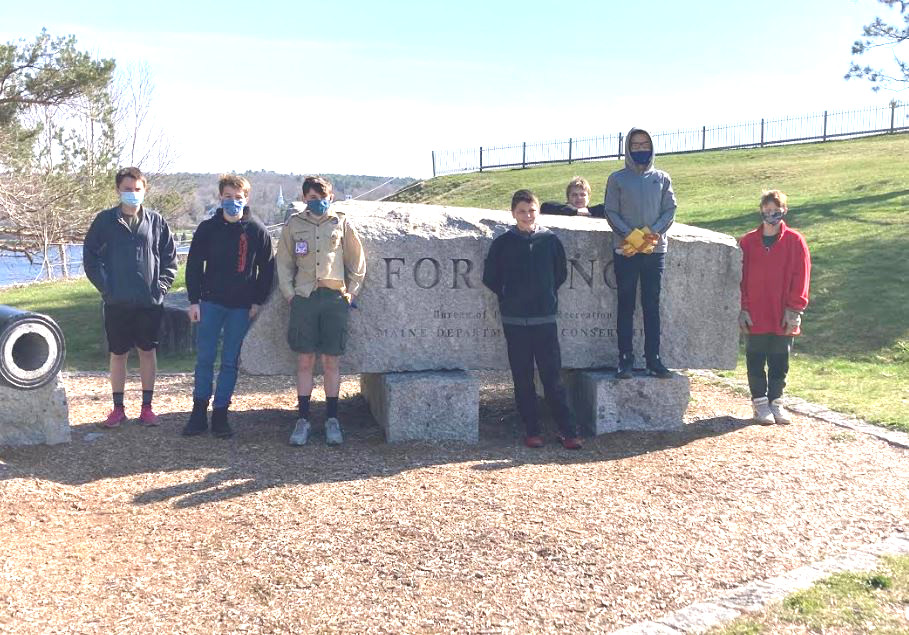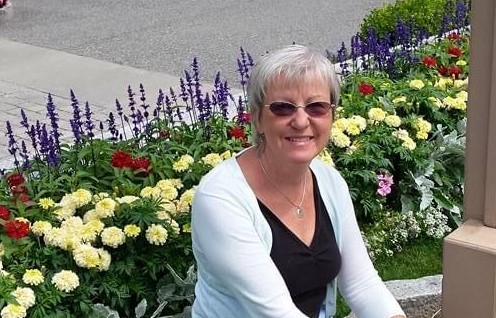Waterville Farmers Market open
 The Waterville Farmers Market is open at the Head of Falls, off Front St., every Thursday, from 2 – 6 p.m.
The Waterville Farmers Market is open at the Head of Falls, off Front St., every Thursday, from 2 – 6 p.m.

 The Waterville Farmers Market is open at the Head of Falls, off Front St., every Thursday, from 2 – 6 p.m.
The Waterville Farmers Market is open at the Head of Falls, off Front St., every Thursday, from 2 – 6 p.m.
Amber Lambke, founder and CEO of Maine Grains, Inc., will speak at the June Leadership Luncheon on Thursday, June 10 from 11:30 a.m. to 1 p.m., at Amici’s Cucina, 137 Main Street, Waterville.
Enjoy a fabulous lunch and meet Amber Lambke, founder and CEO of Maine Grains, Inc.
She will share her vision for the future of growth in the organic grains community, her notable entrepreneurial path and lifelong experiences that propelled her to her current position.
Maine Grains are carried by specialty food stores and used by bakeries, breweries, and chefs throughout the Northeast.
Amber is also the founding director of the nonprofit Maine Grain Alliance whose flagship event, the Kneading Conference, draws hundreds of attendees from around the world each year and has spawned countless similar conferences.
A driving force behind Maine’s sustainable foods movement, Amber has worked with local business leaders and community members to successfully bring the cultivation and processing of grains back to the northeast. Her efforts have generated a broader understanding and appreciation of the flavor, nutrition, economic and environmental value of freshly milled, organic grains.
To register for this event please email Cindy@midmainechamber.com, check the website at www.midmainechamber.com or call 873.3315. Cost for the Leadership Luncheon is $20 per person for members; $25 at the door and for non-members. Lunch is included with the reservation.
Leadership Luncheon sponsors are Kennebec Savings Bank and Central Maine Growth Council.

Waterville Boy Scout Troop #436 members, from left to right, Dresden Laqualia, Sam Bernier, Malakhi Kornsey, Josh Knight, Nick Tibbetts (behind), Tobias Crocker and Xander (who was a guest), stand next to the Fort Knox sign at the entrance. (contributed photo)
On April 24, Boy Scout Troop #436, of Waterville, traveled to Fort Knox Historic Site and the Penobscot Narrows Bridge and Observatory (America’s Original Fort Knox), in Prospect, as part of a service project to ready the park for opening for its season which began on May 1.
Three adults, Bruce Rueger, Jim Kornsey and Dan Bernier, provided support and guidance to the eight youth who took part. The youth were Nick Tibbetts, Tobias Crocker, Malakhi Kornsey, Dresden Laqualia, Sam Bernier, and Josh Knight and a guest.
“Our first assignment was picking up trash in, around and on the fort! The Scouts enjoyed climbing all over the historic fort while doing their good deed. They had fun while lending a hand. That is a win,” said Scouting leader Bruce Rueger. “Our second assignment was going down to the west tower of the Penobscot Narrow Bridge to rake the leaves in the landscaped areas of the parking area near that tower (where the elevator is located).”
Afterwards, the Scouts enjoyed a visit to Camden Hills State Park for a hike. The hike selected was Maiden Cliff. “We did the hike, played on a lot of huge boulders, and found a geocache at the top,” Rueger said. “It was a long day, but a great day for Scouting in Waterville.”

Jeanine Deas
In her new children’s book, Twinkle, Twinkle, Where You Are, Waterville-based children’s book author Jeanine Deas offers a comforting, reassuring message for children everywhere — one especially powerful as we all journey through the pandemic.
“The book is about love and longing,” Jeanine says. “During COVID — and after that — it offers a magical way for children (and adults) to endure times of isolation and separation from family and friends. It encourages us to remain hopeful that we’ll soon be reunited.”
The book began in a most surprising way, as, one morning, Jeanine “spoke” with her deceased mother. “I still feel the energy of our relationship,” Jeanine says. “I begin each day talking to her. One morning, while gazing at her picture, I whispered, ‘Mom, where are you?’ I paused, then said out loud, “I love you so, wherever you are.’ These words were the inspiration for Twinkle, Twinkle, Where You Are.”
Presented in delightful, touching rhymes and illustrated by Meaghan M. Bailey, Twinkle, Twinkle, Where You Are is ultimately a hope-filled picture book with a message that can enrich children throughout their lives.
“My desire,” says Jeanine Deas, “is that readers will come to understand that when distance, time, or even death separate us physically from those we love, we are always connected through the ever-present energy of our relationship. It’s the ‘TWINKLE’ that gives us hope.”
Twinkle, Twinkle, Where You Are is available at Children’s Book Cellar, in Waterville.
 Mid-Maine Chamber of Commerce’s 29th annual Taste of Waterville is planned for Wednesday, August 4, from 11 a.m. to 9 p.m. at the Head of Falls, off Front Street, in downtown Waterville.
Mid-Maine Chamber of Commerce’s 29th annual Taste of Waterville is planned for Wednesday, August 4, from 11 a.m. to 9 p.m. at the Head of Falls, off Front Street, in downtown Waterville.
This year’s format will feature cultural foods and demonstrations focused on the ethnic diversity of the area. Taste of Waterville will be an adult-focused, day-long event with a variety of ethnic food options, entertainment, and informative walks, along with live music, beer/wine gardens and brew samples. Timelines for entertainment and activities are currently under development.
Applications are now being accepted for restaurant, bite booth, food truck and food-related vendor participants. Taste of Waterville encourages participation from both Mid-Maine Chamber members and non-members throughout the region. To reserve a spot for this year’s event, please contact Cindy@midmainechamber.com.
 The Waterville Area Art Society (WAAS) is celebrating 35 years with an art show that includes 150 pieces of art featuring 24 WAAS members. The majority of the show is exhibited at The Framemakers, in Waterville. Some work is also available to view at Selah Tea. To see the show, at The Framemakers, one can make an appointment (872-8927) or come to the store and be admitted as space allows (regarding quarantine restrictions). All pieces of art are for sale and can be virtually viewed and purchased online: https://the-framemakers.square.site This show runs through May 7.
The Waterville Area Art Society (WAAS) is celebrating 35 years with an art show that includes 150 pieces of art featuring 24 WAAS members. The majority of the show is exhibited at The Framemakers, in Waterville. Some work is also available to view at Selah Tea. To see the show, at The Framemakers, one can make an appointment (872-8927) or come to the store and be admitted as space allows (regarding quarantine restrictions). All pieces of art are for sale and can be virtually viewed and purchased online: https://the-framemakers.square.site This show runs through May 7.
The Society also offers a $500 scholarship for graduating seniors planning to major or minor in visual arts, performing arts or music. This scholarship is offered to eight local schools. Applications are due May 1. For more information about scholarships or about membership, you can email: waasmaine@gmail.com or call Mary Morrison at (207) 872-5843.
The art society was started in 1986 to promote visual arts in Maine, encourage local artists and to foster public awareness of Maine artists. Although currently not meeting in person, the group generally meets monthly and provides members with educational programs, art demonstrations, exhibit opportunities, and a place to share information with other artists. The newsletter also provides artists with upcoming exhibitions, juried shows and opportunities.
 In response to Governor Mills’ Moving Maine Forward plan, Waterville Creates is thrilled to announce its plans to resume in-person programming at the Waterville Opera House, Railroad Square Cinema, and various outdoor venues. Waterville Creates’ reopening plan is gradual in its approach and will be guided by strict safety and public health practices and protocols, including social distancing, masking of all staff and patrons, and enhanced cleaning and air filtration systems.
In response to Governor Mills’ Moving Maine Forward plan, Waterville Creates is thrilled to announce its plans to resume in-person programming at the Waterville Opera House, Railroad Square Cinema, and various outdoor venues. Waterville Creates’ reopening plan is gradual in its approach and will be guided by strict safety and public health practices and protocols, including social distancing, masking of all staff and patrons, and enhanced cleaning and air filtration systems.
“We are excited to return to our core mission of providing live, in-person arts experiences,” says Waterville Creates President + CEO Shannon Haines. “We also take our responsibility to protect our community very seriously, and we have developed safety standards and expectations for each of our venues that we will explicitly communicate and enforce in order to meet that responsibility.”
Based on the state’s guidelines, Waterville Creates plans to reopen the Waterville Opera House for rentals beginning June 1 to accommodate spring dance recitals. The maximum capacity of the Opera House with social distancing is less than 250, which is about 30% percent of the venue’s full capacity of 810 seats. “We are incredibly excited to open the Opera House doors and welcome performers back to the stage,” says Waterville Opera House Executive Director Tamsen Brooke Warner. “The health and safety of our patrons, staff, and performers is our top priority, so we will be asking everyone to work together to ensure a safe environment as we resume in-person programming.”
Railroad Square Cinema will open in July with the 24th annual Maine International Film Festival (MIFF) and will remain open with regular first run arthouse film programming after the festival concludes. MIFF, which will be held July 9-18, will also include screenings at the Waterville Opera House and the Skowhegan Drive-In. “While we were thrilled to be able to offer an in-person experience last year at the Drive-In, it was the first time in 23 years that we didn’t host the festival at Railroad Square Cinema,” says Maine Film Center Executive Director Mike Perreault, adding, “We cannot wait to welcome people back to the cinema, and MIFF24 is really the perfect way to do it.”
Plans for reopening Ticonic Gallery + Studios are still in development, in part due to very limited capacity with social distancing, but Waterville Creates anticipates reopening the gallery at the Hathaway Creative Center in the fall.
Waterville Creates will resume outdoor programming with Art in the Park, at the Downtown Waterville Farmers’ Market, from June through September. Art in the Park is a free artmaking programming designed to engage residents of all ages in fun, creative activities in a welcoming environment. Due to popular demand, Waterville Creates, in coordination with its community partners, plans to continue its Art Kits for All distribution program throughout the year. Preliminary plans are also underway to host the popular Waterville Rocks outdoor concert series, but this programming is dependent on the loosening of State restrictions.
Due to the pandemic, the Waterville Opera House rescheduled several concerts over the past year for dates in late summer and early fall 2021, including the Femmes of Rock on August 27, LeAnn Rimes on September 17, and the High Kings on September 30. Plans for these shows are dependent on further relaxation of social distancing requirements and other protocols. The Waterville Opera House will communicate any further event changes to patrons by website, email newsletter, and social media.
All venues will adhere to strict capacity limits based on state guidelines for percentage caps and social distancing requirements. Patrons will be required to wear masks at the venues while not eating or drinking and to participate in outdoor in-person programs. Waterville Creates staff will continue to follow the guidance of government and public health officials and adjust its reopening plans accordingly.
 In keeping with one of its goals, Waterville Rotary Club board voted recently to take $15,000 out of its reserves to offer grants addressing food insecurity in the greater Waterville area.
In keeping with one of its goals, Waterville Rotary Club board voted recently to take $15,000 out of its reserves to offer grants addressing food insecurity in the greater Waterville area.
The Community Services Committee, chaired by KVCAP’s Michele Prince, was charged with developing grant criteria, an application and scoring process for the committee members to fairly evaluate the applications. The maximum possible allotment was $3,000 per application, and the request needed to be submitted by a 501c3.
Due to the demonstrated need in the area, the committee decided to contribute the total of its cups and fines donations for two months to this effort as well, allowing for a total contribution in grants of $15,534.
Eight applications were accepted, with the following list of recipients recommended by the committee, and ratified by the Rotary board:
For more information about Waterville Rotary and its programs, visit the website at http://www.watervillerotary.com.
 Waterville Creates (WC) will receive the 2021 Excellence in Arts Advocacy Award from the Maine Art Education Association. A formal, state-wide recognition ceremony will take place virtually on Saturday, March 13, 2021, and will be hosted by the Portland Museum of Art. The Maine Art Education Association is a statewide professional organization whose members are committed to excellence in visual arts education.
Waterville Creates (WC) will receive the 2021 Excellence in Arts Advocacy Award from the Maine Art Education Association. A formal, state-wide recognition ceremony will take place virtually on Saturday, March 13, 2021, and will be hosted by the Portland Museum of Art. The Maine Art Education Association is a statewide professional organization whose members are committed to excellence in visual arts education.
“This is a testament to your exemplary contributions to support visual arts education. We applaud your leadership, commitment and service to the support of arts education,” says Lynda Leonas, president of the Maine Art Education Association of Portland.
Waterville Creates develops and delivers a wide array of arts education and outreach programs that serve Waterville area residents and their families. WC works with a host of organizational partners to maximize its reach and ensure access for a broad array of community members. “Waterville Creates envisions a community where everyone has access to – and takes part in – high quality and lifelong learning experiences in the arts. This recognition from the Maine Art Education Association is a tremendous acknowledgment of our programmatic efforts,” says Shannon Haines, President + CEO of Waterville Creates.
Led by Education + Outreach Coordinator, Serena Sanborn, WC reimagined existing programs and developed new initiatives to keep the community connected and engaged in the arts through the pandemic. Sanborn virtually hosted numerous art classes and camps through WC’s Facebook page, spearheaded the collaborative Art Kits for All program, which has distributed over 3,500 art kits to area families, and hosted WC’s video series, On the Road.
